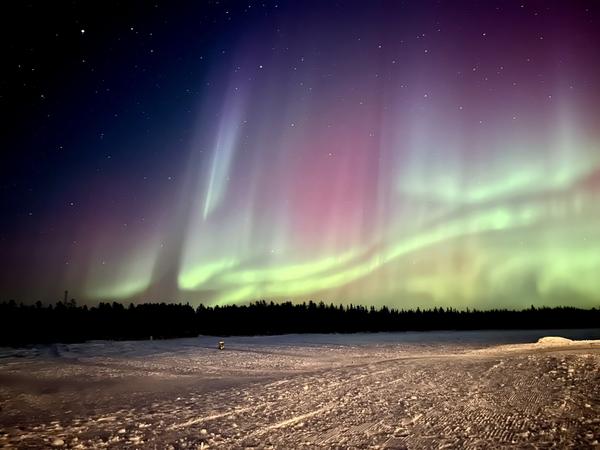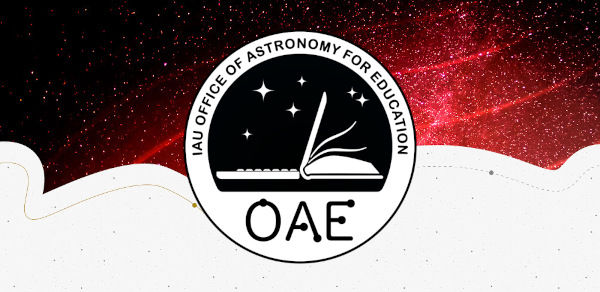This page describes an image Northern Lights Color
Image caption:
This photograph taken with a smartphone captures the ethereal beauty of the Northern Lights at Cassidy Point, Yellowknife, NT, Canada on 24 March 2023, at temperatures well below freezing (–29°C). The mesmerising dance of the Aurora Borealis (Australis), commonly known as the Northern (Southern) Lights, paints the night sky in striking hues. The aurora is a natural phenomenon caused by charged particles from the Sun interacting with Earth’s atmosphere, and being redirected by Earth’s magnetic field towards the north and south polar regions. The charged particles excite atoms and molecules in the atmosphere, resulting in a light display that varies in colour and form. The different colours of an aurora are determined by the gases (atoms and molecules) in Earth's atmosphere, the altitude of the aurora, the density of the atmosphere, and the energy of the charged particles. In general, green is attributed to oxygen molecules, red is associated with high-altitude oxygen molecules, purple and blue are associated with hydrogen and helium, and pink auroras are typically associated with nitrogen. On this particular night, the serene environment of Cassidy Point provided an unobstructed view of the lights. In the foreground, Aurora Village can be seen, a site renowned for organised tours to witness this spectacle.
Scroll to captions in other languages
Image credit:
Jason Johnson/IAU OAE (CC BY 4.0)
DOI: 10.5281/zenodo.10356863
Tags:
astrophotography
Related glossary terms:
Aurora
, Aurora Borealis
, Geomagnetic Storm
Categories:
Naked Eye Astronomy
, Planet Earth
Image license: Creative Commons Attribution 4.0 International (CC BY 4.0) Creative Commons Attribution 4.0 International (CC BY 4.0) icons
The media file captions presented on the OAE website were written, translated and reviewed by a collective effort from the OAE, the OAE Centers and Nodes, the OAE National Astronomy Education Coordinators (NAECs) and other volunteers. You can find a full list of credits for our translation project here. All media file captions are released under a Creative Commons CC BY-4.0 license and should be credited to "IAU OAE". The media files themselves may have different licenses (see above) and should be credited as listed above under "credit".
Captions in Different Languages:
Image caption: Vincitore del concorso di astrofotografia IAU OAE 2023, categoria Immagini fisse con smartphone-dispositivi mobili: Colori dell'Aurora Boreale, di Jason Johnson
Questa fotografia è una delle sei vincitrici della categoria Immagini fisse scattate esclusivamente con smartphone/dispositivi mobili. Cattura la bellezza eterea dell'aurora boreale a Cassidy Point, Yellowknife, NT, Canada, il 24 marzo 2023, a temperature ben al di sotto dello zero (-29°C). L'ipnotica danza dell'Aurora Boreale (Australis) dipinge il cielo notturno con sfumature suggestive. L'aurora è un fenomeno naturale causato da particelle cariche provenienti dal Sole che interagiscono con l'atmosfera terrestre e vengono reindirizzate dal campo magnetico terrestre verso le regioni polari nord e sud. Le particelle cariche eccitano gli atomi e le molecole dell'atmosfera, dando vita a uno spettacolo luminoso che varia nei colori e nella forma. I diversi colori di un'aurora sono determinati dai gas (atomi e molecole) presenti nell'atmosfera terrestre, dall'altitudine dell'aurora, dalla densità dell'atmosfera e dall'energia delle particelle cariche. In generale, il verde è attribuito alle molecole di ossigeno, il rosso è associato alle molecole di ossigeno ad alta quota, il viola e il blu sono associati all'idrogeno e all'elio, mentre le aurore rosa sono tipicamente associate all'azoto. In questa notte particolare, l'ambiente sereno di Cassidy Point ha permesso di vedere le luci senza ostacoli. In primo piano si vede l'Aurora Village, un sito rinomato per i tour organizzati per assistere a questo spettacolo.
Image credit: Jason Johnson/IAU OAE (CC BY 4.0)
Related glossary terms: Aurora , Aurora Boreale , Tempesta Geomagnetica Caption translation status: Not yet approved by a reviewer
Caption translators: Valentina La Parola









